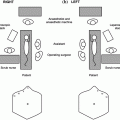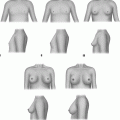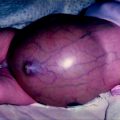Fig. 3.1
Pathway for pediatric thyroid nodules. *Purely cystic lesions, i.e., no solid component, are not managed using this guideline. Surgical consultation may be considered. Recommend external expert review if atypia of undetermined significance occurs on repeat FNA
History and Physical Examination of the Child with a Thyroid Nodule
The evaluation of a child with a thyroid nodule begins with a history and physical examination. Most thyroid nodules are asymptomatic but symptoms of neck pain, difficult or painful swallowing, difficult or noisy breathing, or hoarseness suggest the possibility of local invasion or compression of the airway, esophagus, or recurrent laryngeal nerve. The rate of growth should be assessed. Rapid growth of a thyroid mass classically would suggest anaplastic thyroid cancer or thyroid lymphoma; however, both of these tumors are rare in children. In addition, although most patients with thyroid cancer are euthyroid it is necessary to ask about symptoms of hyper and hypothyroidism [9].
In addition to the history of the thyroid nodule and the state of thyroid function, it is important to ask about a personal history of radiation exposure or thyroid disease and about any family history of thyroid disease, thyroid cancer, or tumors common in familial tumor syndromes.
Physical examination should look for signs of hyper or hypothyroidism and for any of the signs seen in syndromes with a risk of thyroid cancer (see Chap. 4 for specific examples of syndromes with a risk of thyroid cancer). The characteristics of the thyroid nodule—its size, character, tenderness, mobility, and fixation—should be noted. Finally, it is very important to examine for associated cervical lymphadenopathy. However, although a complete history and physical examination is important and necessary to provide optimal care of the patient, by itself it is usually unreliable in making a diagnosis of malignancy [9, 12]. After the history and physical examination the next steps in evaluation of a child with a thyroid nodule are to obtain basic laboratory tests of thyroid function and an ultrasound of the thyroid.
Laboratory Tests to Evaluate Thyroid Nodules
Serum thyroid stimulating hormone (TSH) levels as a measure of thyroid function are indicated in patients with diffuse or focal enlargement of the thyroid gland [5]. When the TSH is lower than normal then a thorough evaluation for hyperthyroidism should be performed including radionuclide thyroid scanning. Radionuclide scanning will identify nodules as “cold” (uptake less than surrounding thyroid), “warm” (uptake equal to surrounding thyroid), or “hot” (uptake greater than surrounding thyroid). “Hot” nodules are hyperfunctioning. Hyperfunctioning thyroid nodules are usually not malignant [5, 9] but patients with laboratory and clinical hyperthyroidism require treatment for the hyperthyroidism that could include surgical excision with a thyroid lobectomy of the hyperfunctioning nodule. When TSH levels are higher than normal (or even in the high normal range) then the thyroid nodule has an increased risk of being malignant [17].
Other laboratory tests have been used in the evaluation of patients with thyroid nodules but there is no consensus about their routine use. Serum thyroglobulin levels can be elevated in patients with differentiated thyroid cancer but similar elevations are found in other, nonmalignant thyroid diseases. Therefore, serum thyroglobulin is neither sensitive nor specific for thyroid cancer and not useful during the evaluation of a thyroid nodule [18]. Serum calcitonin levels have been advocated in the evaluation of thyroid nodules to detect medullary thyroid cancer although this has not been the standard practice in the United States, and probably not warranted as a routine test in childhood thyroid nodules, unless, of course there is a family history of Multiple Endocrine Neoplasia Type 2 or Familial Medullary Cancer syndromes [19–21].
Imaging in the Evaluation of Thyroid Nodules
Ultrasound (US) should be the first imaging study obtained for a thyroid nodule and is often the only imaging study needed during the evaluation [22]. US can identify the number of nodules, their size, and whether they are solid or cystic. In addition, more subtle characteristics such as nodule regularity, vascularity, and the presence of calcifications can be assessed. Ultrasonographic findings suggesting malignancy include nodules with increased peripheral vascularity, irregular, “infiltrative” margins, and microcalcifications [23]. Additional features suggesting malignancy include nodules that are hypoechoic compared to surrounding thyroid and nodule dimensions that are taller than wider in the transverse viewing plane [24, 25]. None of these features is diagnostic for malignancy but may be useful to risk stratify nodules that require biopsy [5]. Some ultrasound features argue against malignancy. For example, pure cystic nodules are rarely malignant [26] and would not typically require further evaluation by biopsy although they might need intervention for their mass effect alone.
The objective of ultrasound in evaluating thyroid nodules is to identify nodules that need further evaluation with a biopsy. The major criteria used to decide if biopsy is needed are size and character of the nodule. As a general rule, thyroid nodules 1 cm or larger in diameter that have solid components should be biopsied [5]. Certain aspects of the patient’s history and physical exam (e.g., a history of radiation exposure [27] or family history of thyroid cancer [28], or exam findings suggesting a syndrome with an increased risk of thyroid cancer) or the finding of ultrasound characteristics of malignancy might cause suspicion and lead to biopsy of nodules smaller than 1 cm. Finally, biopsy is indicated when lesions are seen to be enlarging or especially when they are associated with enlarged cervical lymph nodes [5].
Fine Needle Aspiration of Thyroid Nodules
The technique of biopsy of thyroid lesions to evaluate for malignancy is fine needle aspiration (FNA) [29]. This technique has been used extensively in adults and it has been shown to be equally useful in children [30]. FNA should be performed in children under ultrasound guidance, to ensure proper sampling especially when the nodule has cystic components or when it is small [31]. One unique aspect of FNA in children when compared to adults is the increased need for sedation or even general anesthesia since children are not always as cooperative as adults with even minor procedures.
FNA requires an experienced pathologist to interpret the biopsy specimens and clearly report the findings to the physicians and surgeons caring for the patient. Since biopsy findings are critical to the diagnosis of malignancy and surgical treatment there have been efforts to standardize the reporting of FNA. One standard reporting scheme was the outcome of the National Cancer Institute sponsored thyroid FNA “State of the Science” conference in 2007. Based on these discussions and using the Bethesda System for reporting cervical cytology interpretations as “inspiration,” the National Cancer Institute’s Bethesda System for Reporting Thyroid Cytopathology was developed [32].
This system defines six different categories to describe FNA results:
Nondiagnostic/Unsatisfactory,
Benign,
Atypia of Undetermined Significance or Follicular Lesion of Undetermined Significance,
Follicular Neoplasm or suspicious for a Follicular Neoplasm,
Suspicious for malignancy,
Malignant.
When initial FNA yields an unsatisfactory or nondiagnostic sample then close follow-up with a repeat FNA under US guidance in 3–6 months is recommended and often provides a more definitive answer [33, 34]. Persistently unsatisfactory or nondiagnostic samples, especially when the nodule is solid, when it is growing, or in patients with risk factors for malignancy should lead to the consideration of hemithyroidectomy (lobectomy + isthmusectomy) to obtain a definitive diagnosis and relieve family uncertainty [35].
The other categories of FNA findings have increasing risks of malignancy. The lowest risk of malignancy is for nodules classified as benign where there is a small, but real risk of a false-negative result. Close follow-up of these patients is required [36, 37]. Follow-up should include repeat US and if the nodule is growing then a repeat FNA [2]. Similar to purely cystic nodules, when nodules that are predominantly cystic are benign by FNA and then again accumulate cystic fluid and are symptomatic then hemithyroidectomy can be considered [5]. Another option for treatment of symptomatic, benign cystic nodules that has been described in adults is ablation by injection of ethanol [38].
There is a spectrum malignancy risk among FNAs of indeterminate cytology. Those reported as “atypia” or “follicular lesion of undetermined significance” (AUS/FLUS) have a relatively low (5–10%) risk of malignancy in adulthood [32]. However, the reported rates of malignancy in lesions where the FNA results show AUS/FLUS in childhood is significantly higher and argument can be made to proceed to hemithyroidectomy [39]. Alternatively, with care and selection, these lesions may be observed closely and a repeat FNA done in 3–6 months.
FNAs reported as “suspicious for follicular or Hürthle cell neoplasm” the risk may be as high as 20–30% although the exact risk debatable and may be lower in certain patients. It is impossible to distinguish follicular adenomas from follicular carcinomas because the diagnostic criteria for malignancy are not cytological but rather evidence of capsular or vascular invasion, which requires examination of the whole lesion. Because of the higher risk of malignancy hemithyroidectomy for a definitive diagnosis is recommended [12]. In a meta-analysis of the utility of FNA in children, the issue of finding follicular cells on cytology recognized the difficulty in differentiating benign follicular adenomas from follicular carcinomas. They concluded that the finding of follicular cells on FNA in a child should be viewed as “suspicious for malignancy” and that surgery should proceed [30].
Stay updated, free articles. Join our Telegram channel

Full access? Get Clinical Tree






